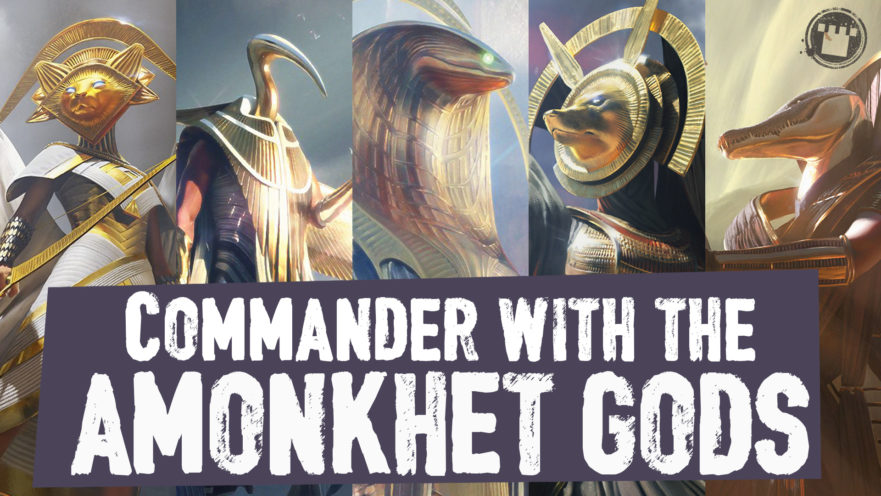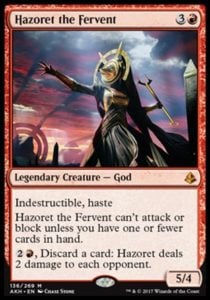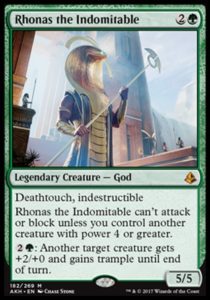(Editor’s Note: Welcome back to the CK Blog! We hope you enjoyed our feature on the hottest red cards in Amonkhet and their applications in Standard and beyond. We’re still talking Amonkhet cards today, but we’ve called on Aaron, Card Kingdom Fulfillment Specialist and resident Commander fan, to share his thoughts on how the new set impacts his favorite format. Enjoy!)
Over the last four years, Theros’s Pantheon of Gods has altered the Commander landscape – improving strong archetypes and making others, like mill, more suitable for a 99-card format. It seemed inevitable that Wizards’ team would return to the template, continuing to explore what it means to be a God in the Multiverse.
Here, we’re going to look at the Amonkhet five – the new, desert-fresh hotness – and see how they might affect the greater Commander environment.
Oketra the True is Truly Deece
Oketra’s design resembles that of the Theros Gods more than any of her Amonkhet counterparts. This is because Oketra’s “Pacifism Clause” (what I’ll be calling the “can’t attack or block” condition) is essentially a game of managing permanents. Any Commander player who has experience with the Theros Gods will therefore have an advantage sleeving up Oketra. White offers tons of protection, more exclusively to white creatures than white permanents, and most Oketra players will be playing 3-5 versions of Brave the Elements to keep their 3/6 double striker attacking. My favorite of these protection spells is Shelter, a tricky little cantrip I’ve seen pop up in Shu Yun lists or white decks that are desperate for a few extra cards. (See also: Akroma’s Blessing, for the sake of cycling.)
The Amonkhet Gods are always creatures, so there are a handful of nifty auras and equipment we can attach to them with minimal risk. Oketra’s vigilance gives her extra potential – the ability is on color, flies under the radar, and helps maximize her skills. If she’s not active, we have other defensive options: Pariah’s Shield is a powerful option for any of the Gods, and playing Oketra will give you access to Pariah itself.
Overall, Oketra is a great Commander for a Mono-White Tokens deck. Consider making the switch if you’re already playing Heliod, Jazal Goldmane, Mikaeus, the Lunarch, or Odric, Master Tactician.
What Can Hazoret “Haz”?
Hazoret’s reveal was polarizing. On one hand, I admired the design. It’s risky, strange, and unapologetic, as it challenges players to test, research, and figure out the card’s role for themselves. These are the kinds of cards that become iconic in Commander – the ones you keep in your arsenal forever. Typically, red is a little more action and a lot less theory-crafting, but I think all the damage Hazoret deals offsets any sense that she’s a niche Commander.
That said, my excitement for this new puzzle was met with some concern for the card’s relevance in Commander. I really like the idea of a creature that rewards me for playing fast, pressure-based Magic, but anyone who’s played the format long enough knows that strong multiplayer decks tend to have a wider range of abilities as opposed to streamlining a deck for consistency. From this angle, Hazoret seems particularly vulnerable, as her “Pacifism Clause” doesn’t provide much flexibility. Hazoret players might struggle to find Wheel of Fortune and its ilk, which let us leverage damage while drawing enough cards to keep up the pressure. Playing in top-deck mode for most of a Commander game seems difficult.
That said, I’m excited to see what people will do to offset the problems and maximize Hazoret’s value. Cards like Avaricious Dragon, Grafted Skullcap, Alhammaret’s Archive, and Lupine Prototype seem incredibly potent starting places for casual decklists. I wouldn’t be surprised if she sees some success in Duel Commander lists, or at the very least, warms a soft spot in your heart for giving her the old college try.
Cool, Cool Kefnet
Kefnet has a blue mana symbol in his casting cost, which means most people will guffaw at me for gushing about him or make silly, jealous comments about boring blue cards. And they aren’t wrong: Blue is a good color in Magic – arguably the best— so it’s no surprise that Kefnet is the way he is. Of course, he’s indestructible; of course, he flies; and of course, he draws cards.
Kefnet isn’t cool because he’s good — he’s just…cool. That may sound lame, but you need only look at other mono-blue Commanders to see what I mean. Azami is popular because she’s better than all her imitators; there are the kitschy Commanders, like Meloku the Clouded Mirror and Patron of the Moon; and then there’s The Unspeakable, which, as his name suggests, requires willing deck-builders to sign a non-disclosure agreement. (Note: No one plays The Unspeakable though, so it’s fine).
Kefnet can fit into existing builds, like Meloku or Patron, but he also has his own deck-building angles, which are wildly different from the rest. From the command zone, consider Kefnet the best Voltron option blue has to offer, as well as a fun way to play pseudo-Sensei’s Divining Top by bouncing Halimar Depths every turn. Mask of Memory and Ophidian Eye effects will keep you drawing cards to keep Kefnet on, turning him into a bigger, better Thieving Magpie.
There, I named a bunch of blue cards people like. I hope I’ve convinced you.
Glory Unto Bontu
Many of the Commander players I’ve talked to have a lot of praise for Bontu, but I’m a bit perplexed. As much as I like this card, I’m skeptical about how it will play, and I’m anxious to see her in action before I form a more definitive opinion.
Unlike the other Gods, Bontu’s mechanical pieces are linear but awkward. Sure, we can get additional value from Dictate of Erebos or Dark Prophecy, but that’s not the confusing part. It’s the timing of these activations and the challenge of using them in the best situations.
Consider Bontu’s role. Does she attack or defend? I’m more inclined to see success with the latter. Having a big blocker gives you the opportunity to maximize your board state by forcing your opponents to decide when they should use removal spells. It’s much more mind-boggling to think about attacking with Bontu and not connecting because your opponents were prepared for menace (which, by the way, is the strangest place I’ve seen this keyword yet).
Like Hazoret, Bontu intrigues me, and I can’t wait to see what the best list looks like. Unlike Hazoret, Bontu’s most likely going to be a Commander that sticks around. I just don’t know how yet.
The Cobra Commander
Any legendary snake in Magic’s history could be worthy of this pun, but I can’t think of one more distinguished, majestic, or worthy than Rhonas the Indomitable. Rhonas is my favorite God in the cycle, and not just because he’s the easiest to get going (or because I’m a sucker for comically large Egyptian masks). The “Pacifism Clause” on Rhonas boasts the smallest barrier to entry relative to attacking, and in the right build, he’ll almost always be useful as soon as he hits the board.
Rhonas is also the best pick for Mono-Green Control, a fringe archetype that’s been invented and reinvented with Thrun and Polukranos over the last five years without much success. With lots of ways to grief our opponents with Hall of Gemstone and Root Maze effects, these decks run just fine; the problem was always the Commander itself. Thrun was a great card, but not a great finisher; Polukranos was a great finisher, but significantly more mana-intensive.
What changes the game is Rhonas’s ability to do the things these other Commanders couldn’t, but cheaper and without the wordy rules text. Without a big buddy, Rhonas can still play some great defense with fight cards. Combining indestructible and deathtouch with old, dusty copies of Predatory Urge, Arena, Sword of Kaldra, and Blight Sickle provides a consistency that neither of the original Mono-Green Control Commanders could offer—remove threats in the early-to-mid-game, and turn the corner and attack when it’s time to do so.
But hey, if you just want to unify all the snakes under one God, indivisible, with liberty and justice for all, you should totally do that. I won’t fight you.
Header design: Chris Rowlands

For most of his Magic-playing life, Aaron has been playing and writing about Commander. One of the few mono-colored players in a gold-bordered world, Aaron enjoys the challenges of creating meaningful, memorable games, as well as the excitement that comes with engaging underrated cards as he explores the format’s uncharted territory. A disciplined deckbuilder with over 200 lists to his name, Aaron has spent the past several years creating content about his favorite format.






